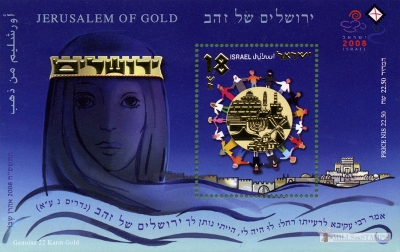-
Jerusalem of Gold
Israel 2008.05.14
In issue: Souvenir sheet(s): 1
Printing: offset with gold embossing, printing in Cartor Security Printers
-
Perforation: Harrow Perforation type: 14 ½x14
Subject:
18 shekel. Price NIS - 22.5 shekel. On souvenir sheet - the girl symbolizing city with the Gold Crown from song "Jerusalem of Gold"*. On the stamp - symbols of Jerusalem. One of them is a stylized Montefiore wimdmill**
Additional:
*The Israeli public first heard Naomi Shemer's song "Jerusalem of Gold" at the close of Independence Day 1967. There were even those who suggested making it Israel's national anthem.
Along with the song, the phrase "Jerusalem of Gold" became well known and many thought that it described the gold plating on the Dome of the Rock atop the Temple Mount or the golden hue of Jerusalem's stone houses in the light of sunrise.
The source of the phrase is actually much more ancient and it appears in the Talmud.
The gold crown resembled a city wall. A number of ancient sources mentioned such a crown and archeological excavations have unearthed mosaics and statues of women wearing crowns resembling the walls of the fortified city.
Over time, the phrase "Jerusalem Gold" was-forgotten, until Naomi Shemer's song brought it back to the forefront.
The mill as built.
**The Moses Montefiore Windmill or Jaffa Gate Windmill is a landmark windmill in Jerusalem, Israel. Built in the Yemin Moshe neighborhood of Jerusalem in 1857, which was then in Ottoman-ruled Palestine, it is 59 feet (18 m) high, and at that time the windmill was an ultra-modern one for grinding grain into flour. It would continue to be used until steam-powered mills made it obsolete.
The windmill was funded by Jewish philanthropist Moses Montefiore who donated large sums of money to promote industry, education and health. Montefiore left an indelible mark on the Jerusalem landscape with the windmill in Yemin Moshe, named after him, which was the first Jewish neighborhood built outside the Old City walls. The funding came from the estate of an American Jew, Judah Touro, who appointed Montefiore executor of his will. The project, bearing the hallmarks of nineteenth century artisanal revival, aimed to promote productive enterprise in the Yishuv. With Montefiore's funding, the windmill and adjacent cottages and almshouses opposite the Old City were able to be built. The mill was built by Messrs Holman Brothers, the Canterbury, Kent millwrights. The stone for the tower was quarried locally. The tower has walls 3 feet (910 mm) thick at the base and is almost 50 feet (15.24 m) high. During construction of the mill, the parts were landed at Jaffa with great difficulty as there were no suitable facilities for landing the heavy machinery. Transport of the various pieces to Jerusalem was by camel. As originally built, the mill had a Kentish style cap and four Patent sails. It was winded by a fantail. The mill drove two pairs of millstones, flour dressers, wheat cleaners and other machinery.
In a book published in 1933 two anecdotes are told surrounding the windmill's construction. The first is that there was much opposition from among the local millers to the windmill, who looked upon it with the evil eye, sending their head man to curse it. Predictions were made that the mill would be washed away during the rainy season, and after it survived intact, it was declared to be the work of Satan. The second is that the Arabs developed a taste for the lubricating oil and would lick the bearings to get at it, prompting fear that the mill would burn down due to bearings running dry. A solution was found by placing a leg of pork in the oil barrel and the Arabs were said to have lost their taste for oil after that.
These activities were part of a broader program to enable the Jews of Palestine to become self supporting in anticipation of the establishment of a Jewish homeland. In addition to the windmill (to provide cheap flour to poor Jews), he built a printing press and textile factory, and helped to finance several agricultural colonies. He also attempted to acquire land for Jewish cultivation, but was hampered by Ottoman restrictions on land sale to non-Muslims.
The mill was not a success due to a lack of wind. The mill had ceased to work by 1891, and after that was used as a studio and a house. Another windmill stood at Rehia, and was of similar appearance, probably being modelled on the Moses Montefiore Mill.
Today, the Moses Montefiore Windmill is a museum dedicated to both the life and word of Moses Montefiore. Next to the windmill they have a reconstruction of Montefiore's carriage.
_____
The design of the stamp in the souvenir sheet is based on the design of the "Jerusalem - 40 Years of Reunification" stamp, issued in May 2007.Size (of sheet, booklet) mm: 70x110
Topics: Stylized mills Windmills



